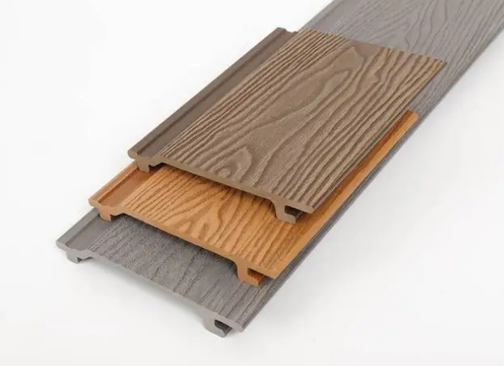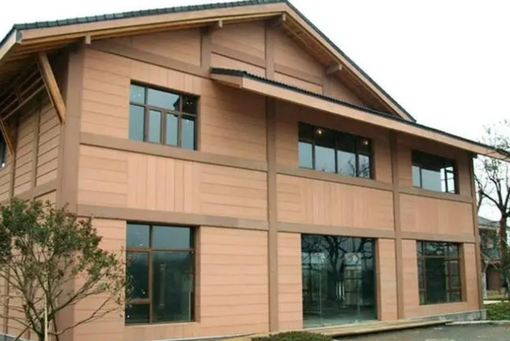Wood-plastic siding is a building material made from a mixture of wood fibers and plastic, and is commonly used for exterior wall coverings of buildings. It combines the advantages of wood and plastic and has many excellent properties, making it increasingly popular in modern construction.

Durability:
It has high weather resistance, can resist various weather conditions such as sunlight, rain, wind and snow, and is not easy to rot, crack or deform.
Low maintenance:
Compared with traditional wood, WPC siding does not require regular painting or sealing and only requires occasional cleaning to maintain its appearance.
Environmental protection:
Wood-plastic materials are usually made from recycled plastics and waste wood fibers, helping to reduce resource waste and environmental pollution.
Aesthetics:
The texture and appearance of natural wood can be simulated, while a variety of color and design options are available to meet the needs of different architectural styles.
Pest prevention:
Due to the plastic content, the exterior wall panels are less susceptible to insect damage and extend their service life.
Easy to install:
Usually using modular design, installation is simple and fast, which can save construction time and cost.


Residential building

Commercial Building

Public building

Resorts and hotels
Installation: Installation usually requires the use of special fasteners and brackets to ensure that the connection between the panels is firm and to reserve appropriate expansion joints to cope with the expansion or contraction of the material caused by temperature changes.
Maintenance: Although WPC siding requires less maintenance, regular cleaning is recommended to prevent the build-up of dust and dirt. Just use a mild detergent and a soft brush to clean, avoid using high-pressure water guns or sharp tools to avoid damaging the surface.
Preparation:
Measure and plan: Measure and plan the installation location of the wood plastic exterior wall panels according to the size and design of the wall. Make sure to take detailed measurements and markings before installation.
Wall treatment: Clean the wall to make sure it is smooth, dry and free of debris. If the wall is uneven, appropriate trimming or studs may be required to level the wall.
Install keel:
Fixed keel: The keel (usually a wooden or metal support structure) is fixed to the wall. The spacing between the keels is usually between 30-50 cm. Make sure the keels are installed flat, firmly, and perpendicular to the wall.
Level adjustment: Use a level to check the level and verticality of the keel to ensure it is on a flat surface.
Install waterproof layer:
If necessary, a waterproof layer can be installed between the keel and the exterior wall panel to enhance the waterproof performance of the wall.
Install the starter board:
Fix the starting board: Install the starting board starting from the bottom and fix it to the keel. Make sure the starting board is level, use a level to adjust.
Reserve expansion joints: Reserve appropriate expansion joints during installation to cope with material expansion or contraction caused by temperature changes.
Installation of wood plastic exterior wall panels:
Installation piece by piece: Fix each wood-plastic exterior wall panel on the keel in sequence according to the design direction. Appropriate spacing should be maintained between each board to ensure aesthetics and telescopic needs.
Fixing screws: Use stainless steel screws or special fixings to fix the panels. The screws should be evenly distributed and ensure that each panel is firmly fixed.
Alignment and Adjustment: After every few boards are installed, check their alignment and make adjustments if necessary.
Work on corners and details:
Corner closing: For the corners and edges, special edge strips can be used to ensure the beauty and waterproof performance of the corners.
Caulking: Use sealant or caulking agent between the board joints and the edge strips to enhance the waterproofing effect.
It is a modern building material that combines the advantages of wood and plastic. It has many advantages such as durability, low maintenance, and environmental protection, and is suitable for various construction projects. It not only provides a beautiful appearance, but also effectively extends the service life of the building, making it an ideal choice for modern building exterior wall covering.
Hot Tags: wpc panels for exterior walls, China wpc panels for exterior walls manufacturers, suppliers, Lightweight Steel Frame Houses, Prefabricated Light Gauge Steel Building, Prefab A Frame House, Outdoor Decorative Wall Cladding Panel, 3D Waterproof WPC Wall Panel, Outdoor Garden Composite Fence









